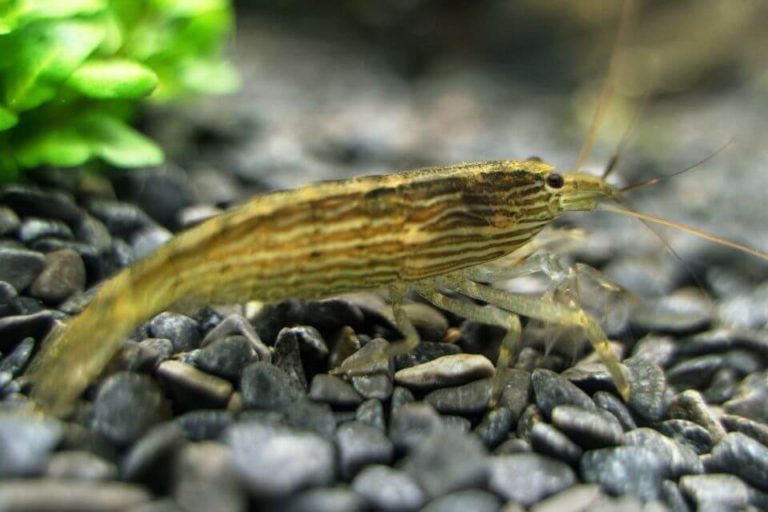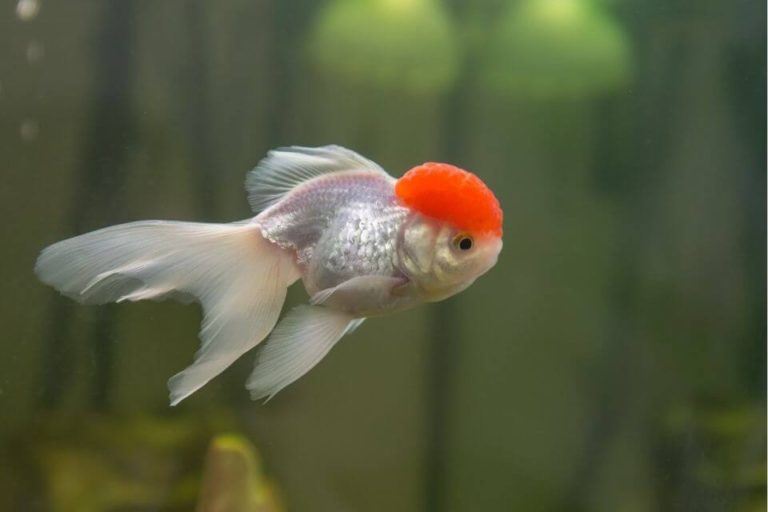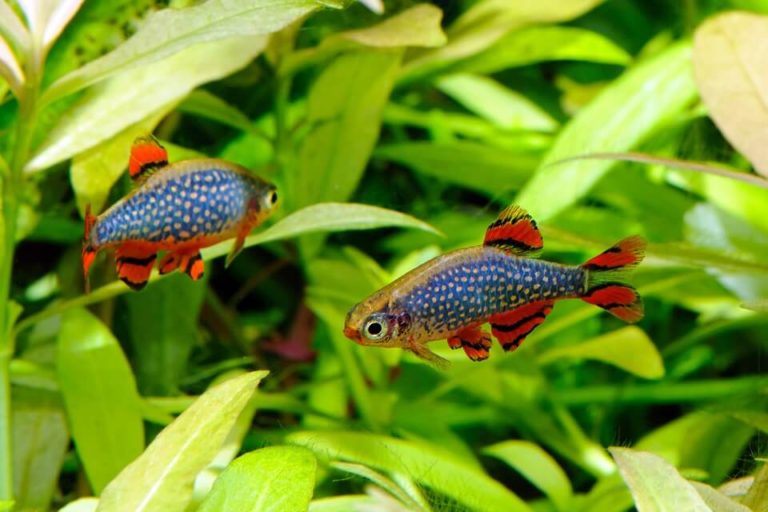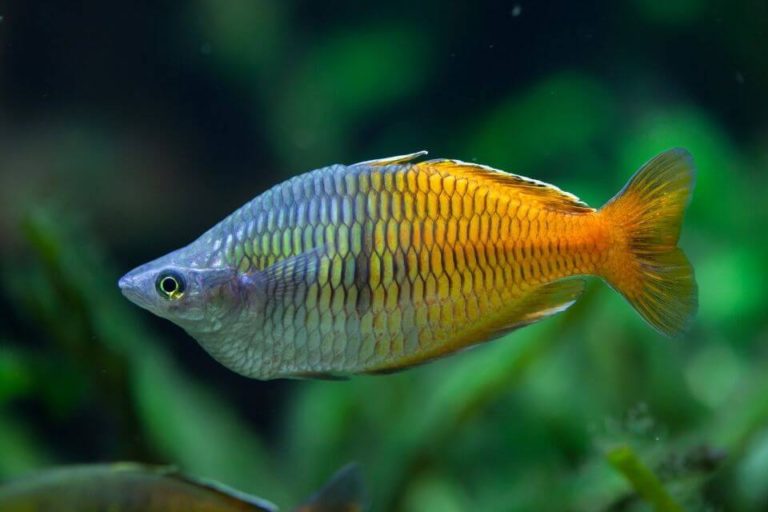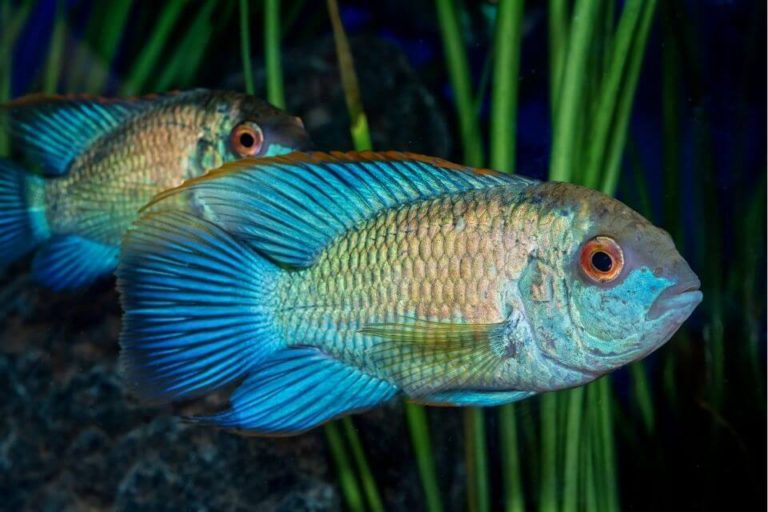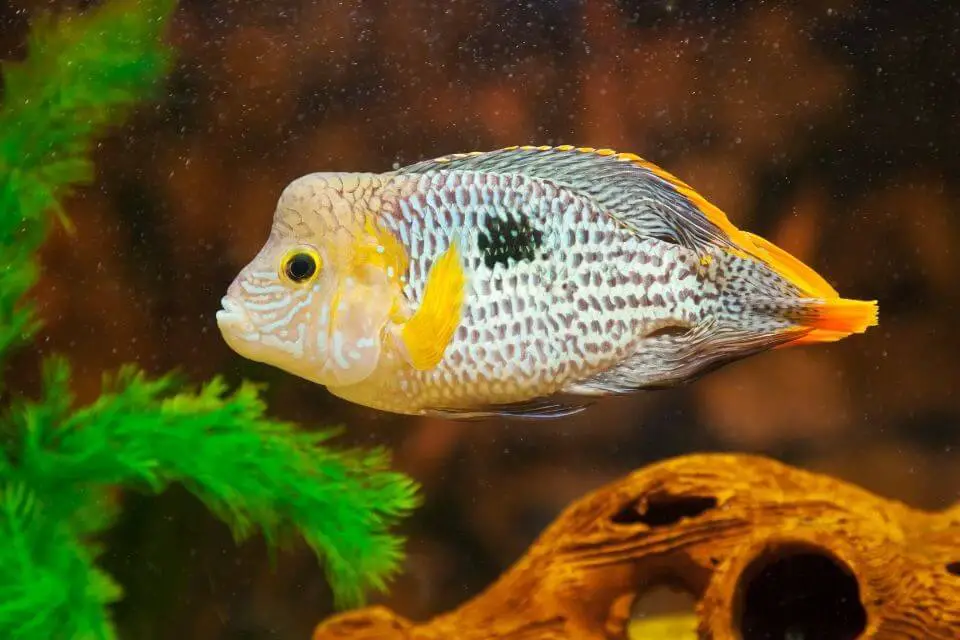Silver Arowana Care: Size, Lifespan, Diet, Tank Size and Best Tank Mates
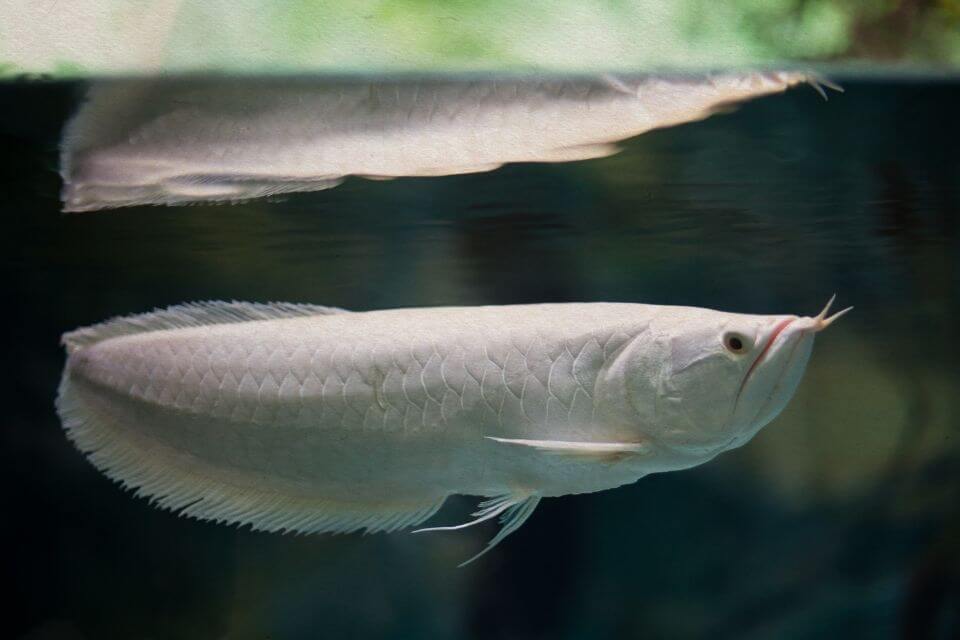
Silver Arowana fish is one of the most desirable fish among expert aquarists. While this fish might be too difficult for beginners to keep, that does not stop it from being heavily sought after by aquarium lovers all across the globe.
Caring for your Silver Arowana can be easy as long as you understand this fish’s unique personality and care needs. With the right tank conditions and setup, the will easily become your most prized possession.
If you are an experienced tank owner, keep reading to learn more about caring for this fantastic freshwater fish species.
| Quick Facts: | |
|---|---|
| Common Names : | Silver Arowana |
| Origin : | Tropical water bodies in South America, Amazon River Basin |
| Family : | Osteoglossidae |
| Scientific Name : | Osteoglossum bicirrhosum |
| Care Level : | Medium to Hard |
| Temperament : | Semi-aggressive |
| Social : | Territorial |
| Diet : | Carnivore |
| Size (average) : | up to 36 inches long |
| Lifespan : | 10 - 15 years |
| Breeding : | Egg layer |
| Minimum Tank Size: | 250 gallons |
| Tank Environment : | Freshwater Sandy and grave mixed substrate, Rocks and Caves, Driftwood, Live aquarium plants (strong-rooted) Plastic aquarium plants |
| Temperature : | 75 – 82 °F (24 – 28 °C) |
| Water Hardness : | 1 - 8 dGH |
| Water pH Level : | 6.0 - 7.5 |
Overview of Silver Arowana
Like many large and fairly aggressive fish, the Silver Arowana fish has a huge reputation that makes it so desirable among fishkeepers who are looking for a challenge.
It is a beautiful fish that measures as one of the largest freshwater fish that you can own in a tank at home. If you are trying to turn fish keeping into a hobby, you can put them on the top of the collector’s list.
They look and act like predators. Their behaviors have earned them the nickname Dragon Fish because of their high aggression. This makes it challenging to care for them in a tank – but not impossible.
It is important to regularly maintain their tank and diet in order to successfully keep it in your tank.
Silver Arowana Size
Silver Arowana size has been measured at over four feet long when fully grown in the wild. In captivity, they can get almost as big. In the wild, the Silver Arowana size has gotten as long as 47 inches (120 cm) in the span of their lifetimes.
You can expect your full grown Silver Arowana size to measure between 15 and 36 inches. As an adolescent, the fish grows at a rate of one inch per month, making it a very fast grower.
Silver Arowana Lifespan
If your Silver Arowana fish lives in a large tank with plenty of space and a high-quality diet, you can expect your fish to live for up to 15 years in your aquarium.
A healthy Arowana should live for at least a decade, provided it has ample living conditions and a stress-free environment.
Silver Arowana Typical Behavior
Most aquarium fish are not purely predatory, but the Silver Arowana fish comes close. They are carnivorous fish that will actively try to attack or bully other members of the tank.
Their wide-open mouths will swallow anything that fits inside, so it’s best to be careful when keeping them around other fish! You must exercise caution when keeping these Arowanas in a tank with other fish.
They will usually try to hunt smaller creatures down. But when they are by themselves, they can actually display shy and skittish behaviors.
As highly intelligent fish, Silver Arowana fish are always aware of what is going on in their environment and they can tell when you are watching them.
Note: Silver Arowanas love to jump! They are often spotted jumping out of the water to grab nearby bugs or other food just above the water’s surface. It is very important that your tank is fixed with a lid that cannot be pushed off.
Silver Arowana Appearance and Colors
These fish have some of the most unique characteristics that you can find in aquarium fish. They are a type of fish known as “band” fishes because they resemble long bands or ribbons of glistening scales when they swim in the water.
This beauty makes them very alluring, but their aggressive behavior is still something to keep in mind. They do not get along with others of their own kind, making them difficult to keep in groups.
If you plan on having one in your aquarium, you should not consider more than one or two at a time. When looking at them from the side, they appear very flat.
This long and slender fish can be wide when you look at it head-on; otherwise, you can expect their bodies to be lengthy and tapered.

Silver Arowana fish gets its name from the shimmering silver scales that run along its body and fade away at the tailfin. There is also a dorsal and anal fin that both extend downward from the body, lending themselves to that violent and predatory appearance.
Their tailfins are smaller than average, making their shape look even more disproportionate. At first glance, the tailfins seem to just be an extension of the fish’s body.
Since the fish is so long, it uses its body to make movements, not relying very much on the tailfin to do much work. The mouth and jaws of the Silver Arowana fish are perhaps the most iconic.
Two signature barbels extend from the bottom mouth. Speaking of the mouth, it sits on a hinge-like jaw to consume large amounts of food at once.
The mouth is almost completely vertical, making it silent when it opens to take in new prey. There are almost no gender differences between males and females.
Silver Arowana Care and Habitat Setup
The biggest reason why they are not recommended for beginners is that they have very strict tank requirements. Their conditions and environment are essential to their survival.
It can be difficult to maintain the exact tank size and specifications needed for these fish, so you should pay extra attention to this monster’s care needs.
Tank conditions must be very unique and specific in order to continuously provide good care for a fish as big and as aggressive as a Silver Arowana fish.
From the size to the water conditions, many elements of the aquarium must be monitored and balanced so you can provide the perfect habitat for your fish.
– Silver Arowana Tank Size
As one of the largest freshwater fish that you can own in a tank, these big beauties will naturally require one of the largest tank sizes available.
For this reason, it is recommended that you start out with a Silver Arowana tank size of at least 250 gallons per adult fish.
If you are still raising juveniles, they can survive in tanks as small as 60 gallons. But you should keep them knowing that you will have to upgrade to a larger tank as soon as the Silver Arowanas are grown.
Most aquarists decide to invest in a tank that is already large enough to hold an adult so the juvenile can grow in comfort.
Silver Arowana tank size is incredibly important if the tank size is too small will cause the fish to feel cramped and claustrophobic, leading to increased stress and aggression.
– Silver Arowana Tank Setup
This fish species are active and like to swim around a lot. They will require plenty of open space within the tank to move their bodies.
However, you can still add plants, substrate, and decorations to the tank to make it a more suitable environment – and one that is aesthetically pleasing!
These fish do not usually hang out near the bottom of the tank, but a suitable substrate is still important. The best substrate would be fine gravel or sand that can support plants with strong roots.
Make sure nothing in the ground can be dug up by these curious hunting fish. It is also appropriate to add some rocks and driftwood to the tank environment.
Your fish will enjoy having some spaces to hide behind as well as search for sustenance.
– Suitable Plants
You shouldn’t add too many plants to your tank as these Arowanas need plenty of space to swim around. A few natural plants will do the tank well as long as they are sturdy and cannot be dug up.
Plants should be arranged sparingly along the back of the tank, leaving the front and top open. You can choose to add floating plants or a few friendly plants with tough roots such as Amazon Sword.
Plastic and silk plants are also suitable options, just make sure not to add too many of them.
– Water Conditions and Parameters
Because Silver Arowanas are found in several different types of water in the wild, their water parameters can vary. It is still important to fall within the recommended ranges of temperature, acidity, and hardness so your fish will always remain comfortable.
Make sure to invest in a water testing kit and test fairly regularly so that you can make adjustments if needed.
Most Arowanas are flexible and can deal with a little bit of fluctuation in temperature and hardness, but it is always important to monitor the individual health of the fish to determine what the best water conditions are.
-
Water Temperature
You should always keep your water temperature levels between 75°F and 82°F at all times. As freshwater tropical fish, they are used to more humid temperatures
-
Water pH Levels
Your water shouldn’t be too acidic or too alkaline. Water acidity levels between 5.0pH and 7.5pH should work just fine. It’s okay to fall within this range, as long as you do not go outside of it.
-
Water Hardness
There is a large range allowed when it comes to water hardness. As Arowanas are used to several different conditions, you can have a degree of flexibility with this level. Make sure the water hardness levels are between 1 and 8 dKH.
Diet and Feeding
It is not difficult to find out what Silver Arowana fish like to eat; maintaining their feeding schedule is important for their growth and survival.
In the wild, these fish eat almost anything that can fit into their mouths, from smaller fish to bugs and frogs. They have even been known to eat snakes and rabbits when they can catch them.
It is a good idea to mimic this natural diet as much as you can when you have a Silver Arowana fish at home. For this reason, you should invest in a healthy mix of live and frozen protein options as well as some supplemental treats.
Some good daily food options include:
- Feeder fish (minnows, etc.)
- Shrimp
- Crickets
- Crab
Make sure to supplement their diet with frozen foods and treats such as:
- Earthworms
- Bloodworms
- Dried pellets
It is important to give your Arowanas a healthy and natural diet with plenty of hearty foods. They eat often, and they eat a lot, so make sure to keep them on a consistent feeding schedule.
Common Diseases
Since they are such a large and carnivorous fish, Silver Arowana fish can, unfortunately, be susceptible to a range of underwater diseases. There are several common fish conditions as well as water-based infections to be aware of.
Ich
One of the most common diseases to develop in fish, Ich is a skin condition that makes fish want to itch themselves against rocks and props.
This can also cause red or blotchy patches on the skin, which is a clear indication that something in the water is causing this condition to form. There is a medication available to help with Ich.
Dropsy
In addition to Ich, Dropsy is another common disease that affects the lungs. This is especially prevalent in juvenile Silver Arowanas, so be on the lookout for this when you raise them.
Parasitic and Fungal Infections
Depending on the quality and contamination of the water in your tank, your fish can be susceptible to several infections.
This can lead to fin rot and other conditions that will make your fish appear frayed, sickly, and stressed. It is important to assess the water conditions in the tank and make any immediate changes that need to be made.
Between the quality of the water and the overall environment of the tank, there could be an underlying cause of illness throughout your aquarium.
Silver Arowana Gender Differences
It can be difficult to distinguish between a male and female Silver Arowana fish. The trained eye may be able to note the subtle differences, which are few and far between.
For example, female Arowanas are typically a little bit plumper, whereas males will usually have a longer anal fin. Apart from these small physical differences, there is no way to tell between a male and female Silver Arowana at first glance.
If you are interested in breeding Silver Arowanas, you may want to learn more about sexing these fish and setting up the right breeding establishment so you can successfully house the fry.
The breeding process between these fish is very unique and can be difficult to do successfully while the fish are in captivity.
Breeding the Silver Arowana
For the most part, aquarists and fish owners do not try to breed Silver Arowanas because it is a very difficult and delicate process. What happens is quite miraculous: When the female is ready to breed, she will lay her eggs.
The male will then fertilize the eggs and then hold them in his mouth, which will stay there for up to 50 days until they hatch, and then 5 weeks until they are ready to swim.
This protects the fry from other predators but it can still be difficult to protect them when the time comes for them to be free.
The male will release the fry out of his mouth as the fish are ready to be born, and this runs the risk of the fry getting eaten by other fish in the tank.
If you want to breed Silver Arowanas, you may need to consult with an expert or carry a second tank that can be used just for the breeding process.
Silver Arowana Tank Mates
Finding the perfect Silver Arowana tank mates can be somewhat challenging. This is mostly due to their size and aggression. However, it is not impossible to find good tank mates that can live in harmony with Silver Arowanas in your aquarium.
Silver Arowanas may not make their own good company, so it is suggested to only have a couple in one tank at a time.
They may become territorial and fight over food and space, especially if you are feeling cramped. (If you have a large pond or an enormous tank where they can stay well out of each other’s way, you can invest in more.)
There are still some fish that make good Silver Arowana Tank Mates are;
- Oscars
- Green Terror Cichlids
- Black Ghost Knife Fish
- Large Plecostomus
- Jaguar Cichlid
- Iridescent Shark Catfish
- Senegal Bichir
The best tankmates are fish who are also quite large and can also be aggressive. You don’t want your fish to fight each other, but it might be a good idea to house fish who can hold their own in the event of a confrontation.
Origin, Distribution, and Availability
Silver Arowanas are native to South America, specifically the Amazon River Basin. They can be found both in black and white waters in the wild, making them easy to locate and catch.
The Silver Arowana is one of the more expensive aquarium fish to keep due to its size and aggressive behaviors. They are not endangered or illegal, but they are often compared to their counterparts, Asian Arowanas, which are illegal.
For this reason, many tank owners seek out Silver Arowanas since they are so similar. This can sometimes make them difficult to acquire.
FAQs
Are Silver Arowanas Illegal?
Silver Arrowanas are not illegal to purchase or own in the United States. They belong to the same family as the Asian Arowana, which is an illegal fish to own and buy in the united states.
If you live in Canada or the UK, or any other country, you can find Asian Arowanas without issue. Asian Arowanas became an endangered species which is why most countries have banned their distribution.
This is another reason why Silver Arowanas are so popular as they are a great alternative for other illegal species of fish.
Why Silver Arowana is So Expensive?
Silver Arowana is one of the more expensive freshwater fish species available in the aquarium pet market. The reason, they are so pricy is that they are very popular and in high demand. Also, the Silver Arowana is so difficult to breed.
These giant monsters are incredibly valuable, and they can sometimes be hard to find through the local aquarium pet market.
Are Silver Arowanas Aggressive?
Silver Arowanas are very aggressive. In fact, they are one of the most predatory freshwater fish that you can own. They will often bully smaller fish and they are even known to fight each other when there isn’t enough space in the tank.
This can make it difficult for fish keepers to find good tank mates and establish a good environment for these massive fish.
Do Silver Arowanas Eat Other Fish?
When given the chance. Silver Arowanas will eat other fish and creatures that are small enough to fit in their wide-open mouth. Due to the size of its mouth and the way it opens vertically to accept food, it is very easy for Silver Arowanas to trap and swallow their prey.
Feeder fish are recommended as a part of the Arowana’s diet since these fish are carnivores in nature. Just make sure they don’t eat their tank mates!
Will Arowana Bite Humans?
Many owners of Silver Arowanas have reported that their fish have bitten them when they get too close. Due to the aggressive nature and defensive tendencies of this fish species, it is easy to assume that your fingers have a high risk of being bitten.
The Arowana has sharp teeth, so being bitten is something you should try to avoid. There are ways to care for your fish without risking them biting you or other fish.
This is why it might take a more experienced aquarist to properly care for these feisty giants.
Final Thoughts of Keeping a Silver Arowana
A prized possession of many aquarium enthusiasts, the Silver Arowana is a huge freshwater fish with the potential to add a lot of value and personality to your tank.
Caring for them is not easy, so it may take a more experienced person to properly take care of these creatures. Due to their size and how quickly they grow, they need a tank that is at least 250 gallons.
If you are prepared to hold a tank that size and consistently monitor the conditions required for keeping Silver Arowanas in good health. You can use this guide to keep you going in the right direction.
With any luck, you will get your hands on Silver Arowana to be the envy of all fish keepers near you.


